Pauline Marie FS-??? (1/2)
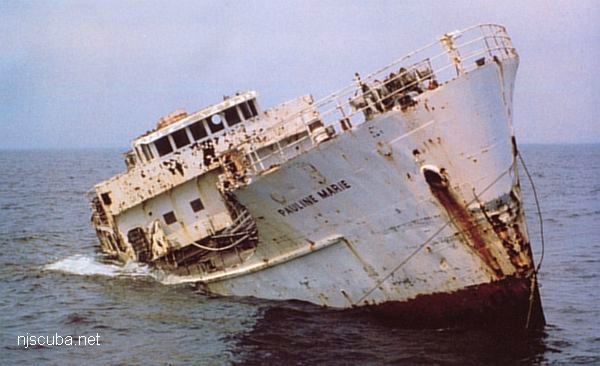
- Type:
- artificial reef, freighter, USA
- Built:
- 1944/1945 USA as FS-??? (US Army Design 381)
- Specs:
- ( 176 x 32 ft ) 560 tons
- Sponsor:
- Seacoast Products Inc, Fisherman Magazine
- Sunk:
- Friday March 29, 1985 - Atlantic City Artificial Reef
- GPS:
- 39°13.763' -74°12.182'
- Depth:
- 85 ft
The Pauline Marie was a WWII-vintage Army FS-class light cargo ship, design 381. The Army had over 500 of these little freighters, some of which it transferred to the Navy, where they were re-designated AKL. The Army did not give them names, but the Navy did name some of their AKLs. Most of the Army's boats were manned by the Coast Guard. The design proved to be highly adaptable after the war.
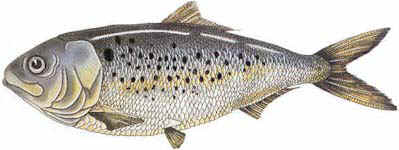
The vessel was donated by Seacoast Products - a menhaden fishing concern, which had plants in Port Monmouth NJ (closed 1981) and Lewes Delaware. They had planned to use it as a purse seiner but were bought out by Omega Protein in 1984, and Omega apparently scrapped the vessel instead. Menhaden, or "bunker", is an inedible type of herring which is processed into fish meal and oil, used in fertilizers and animal feeds. The plant in Port Monmouth (which as I recall gave off a horrendous smell that pervaded the entire area) was torn down around 1987, and the site is now vacant and decaying. Seacoast even had a private airfield for spotter planes there; the runway is now used for leaf composting.
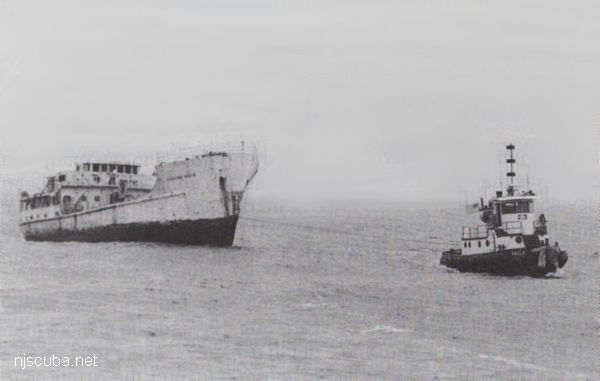
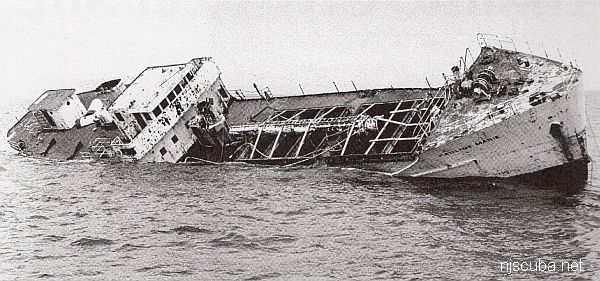
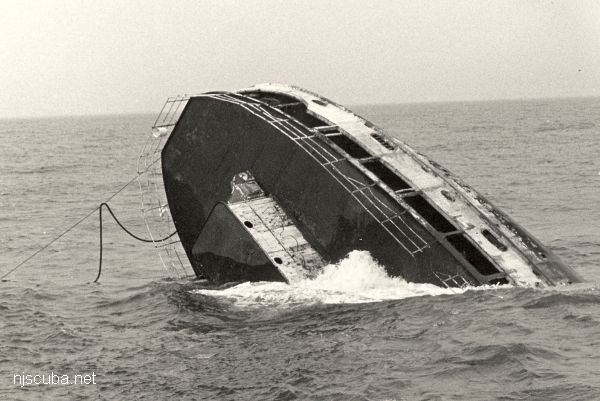
The Pauline Marie lies on her starboard side, with the bow pointing north. She rises some 30 ft off the sandy bottom and can be easily penetrated.
SHIP SCUTTLED TO CREATE 5th FISHING REEF
By Marion Wiessner
New York Times
April 14, 1985
In a continuing program designed to improve sport and commercial fishing along New Jersey's 125 miles of coastline and generate more revenue from it, the state's Department of Environmental Protection has added a fifth artificial reef. According to the department, $750 million was generated last year from offshore fishing.
The program is conducted by the department's Bureau of Marine Fisheries, which, in the last two years, has created four other artificial reefs, off Manasquan, Ocean City, Harvey Cedars and Spray Beach. The bureau is an arm of the environmental agency's Division of Fish, Game and Wildlife.
On March 29, a freighter, the Pauline Marie, was sunk 12 miles off Absecon Inlet to begin the fifth artificial reef. As several boatloads of observers watched, three charges blew holes in the freighter's stern and bow. The vessel rapidly listed to starboard and disappeared. She is now in 95 feet of water.
The scuttling was a cooperative effort of the state division, Seacoast Products Inc. of Port Monmouth and The Fisherman, a magazine published in Point Pleasant. Seacoast Products, which until October 1983 operated a menhaden processing plant on Raritan Bay, donated the freighter. (Menhaden, a member of the herring family, is ground and used as bait or for making oil and fertilizer.)
Brian Harris, a consulting engineer for Seacoast's parent company, Hanson Industries of Iselin, said that the vessel, originally outfitted with a heavy-lift mast and booms, had probably been used to handle missiles and targets for the Army. After World War II, a Portuguese family bought the ship to carry wine and cheese from Lisbon to New Bedford, Mass. Seacoast then bought the freighter to convert her into a menhaden fishing vessel, ''but it was about 20 feet too short * for our purposes,'' Mr. Harris said.
The total cost of cleaning, towing and scuttling was $12,000, ** with the state paying $7,000 and The Fisherman the balance. All loose materials and batteries were removed, fuel and lubricants were drained or steam-cleaned from tanks, generators, engines and other equipment, and the mast, stack and part of the wheelhouse were cut down and fastened to the ship. Peter Barrett, the magazine's senior editor, said the funds had been raised through private donations and proceeds from fishing tournaments. ''It's our way of putting something back into the sport,'' he said.
William Figley, a state fisheries biologist and coordinator of the reef projects, said that the reefs had quickly attracted a variety of fish. ''About four weeks after we dropped tires off Spray Beach,'' he said, ''we dived on the reef site and found thousands of sea bass, along with some porgies and cunner." (Spray Beach is in Ocean County.)
''Basically, the ocean bottom out to the Continental Shelf is low, undulating sand dunes. There is lots of food on the bottom, such as clams and worms, but the relatively flat bottom is not as productive as a rocky bottom.
''The purpose of the reefs is to create habitat for fish and shellfish and to provide a place to go fishing.''
The Pauline Marie is at the inshore edge of what is known as The Lobster Hole.
* "Bunker boats" carry two large (~40ft.) aluminum motor skiffs to set out the nets. These require a lot of space - see Reedville. This reason doesn't really hold water, as the FS design was actually highly sought-after for bunker fishing, and was considered ideal for the job.
** $34,000 in 2023
Normally, it's not difficult to determine a ship's origin - just find the brass builder's plaque, usually in the engine room. In the case of the Pauline Marie, the plaque must have been missing. The design is clearly an Army FS-type 381 freighter. I combed through the records years ago and came up with a few candidates out of the hundreds that were built, but nothing conclusive. Recently I found the article above while looking for something else, and decided to try again with the new information dated right after the sinking. Omega Protein bought-out Seacoast Products in 1984.
Pauline Marie was apparently named Nova Sintra when in use for the trans-Atlantic trade:
The driver of the operation of these ships was one of the most famous captains of the Portuguese merchant navy of the twentieth century, the Cte. Passos Gouveia, from Funchal, * who was already over 70 years old when he decided to emigrate to the USA and start over there. Pauline Marie made a regular stopover in Lisbon, where it was sponsored by the Azorean Mutualist. Nova Sintra had a sister Eugenio Tavares in the 1970s that was also a former US vessel.
The Pauline Marie, ex-Nova Sintra was a former FS Design 330, built in 1943 at Sturgeon Bay, Great Lakes, USA, had 497 grt, a, 52 M long and two GM diesel engines with 1000 HP, 12k of maximum speed, but normally sailed at 8/9 miles.
A twin ship was in the Azores in support of the American forces in Santa Maria and was to be sold to the Azorean Mutualist, but the stubbornness and stupidity of the Portuguese government prevented the deal, which even included two new engines. Eugenio Tavares was the same type, and was a US Coast Guard lighthouse tender. It ran aground and was destroyed in 1977 on the island of Brava (?)
* Passos Gouveia has a tugboat and a street named after him, that's all I can find.
translated from:
https://ship-spotting-in-faial.blogspot.com/2010/02/pauline-marie-i.html
other citations as well
One problem with this account is that only Higgins built Design 330, while most other yards, including Sturgeon Bay, only built Design 381. (At a glance, the two are identical.) But the rest of the details jibe, and that part looks like a cut-and-paste mistake. Sturgeon Bay narrows the possibilities down to FS-361, FS-367 and FS-373, and FS-361 was on the West Coast. The "lighthouse tender" note is also highly suspect.
At some point in the trading service, Nova Sintra was renamed Pauline Marie. The first Pauline Marie was later replaced by a newer larger Pauline Marie I, a vessel of the same class as the Pinta. That vessel (IMO 5396583) was built in 1962, as Yselhaven, but re-named Pauline Marie in 1979, which is probably when it replaced the first one, unless the owner really liked that name and wanted to have two.
My guess is that Pauline Marie went out of service in 1979. She was bought by Seacoast some time after that, but was never put to use. I suspect there was something wrong with the vessel that could not be fixed, and not just the engines. Old hulls wear out from corrosion and fatigue. When Omega bought-out Seacoast, they got rid of the Pauline Marie the easiest way they could - donated as a reef. Pauline Marie never entered Omega's fleet records.
Right now, the best candidate for the Pauline Marie is FS-373, simply because every other vessel has some history or other detail that makes it less likely, or impossible. FS-373 wins because it has no known history at all. That may change.


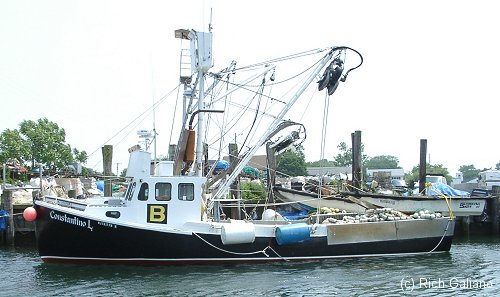
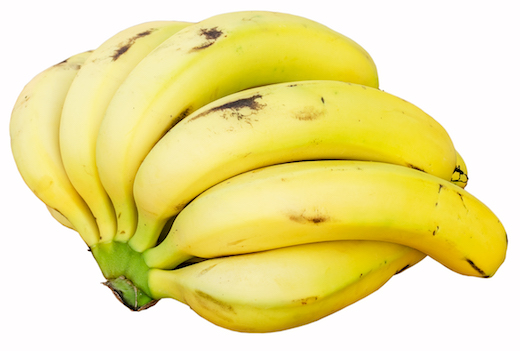
Questions or Inquiries?
Just want to say Hello? Sign the .